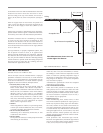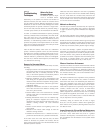
SYSTEM SENSOR
be mounted on the wall. Wall-mounted detectors should be
located not less than 4 inches nor more than 12 inches
from the ceiling to the top of the detector, and at least 4
inches (10 cm) from any corner wall junction. (See Figure
18.)
When air supply and/or air return ducts are present in a
room or space, the detector(s) should not be placed in the
path of the air flow supply or return duct (NFPA 72, 1999
Edition).
Smoke tests are helpful in determining proper placement.
Special attention should be given to smoke travel directions
and velocity, since either can affect detector performance.
Placement of detectors near air conditioning or incoming
air vents can also cause excessive accumulation of dust
and dirt on the detectors. This dirt can cause detectors to
malfunction and cause unwanted alarms. Detectors should
not be located closer than 3 feet from an air supply diffuser
or an air return vent.
Spot type detectors, in properly engineered systems, may
also be placed in return air ducts, or in approved duct
detector housings designed for this application. Although
duct detectors are not a substitute for open area detectors,
they can provide an effective method of initiating building
control functions to prevent smoke from being transported
from the fire area to other parts of a building. (See Duct
Smoke Detector Applications Guide.)
Ceiling
Acceptable Here
Never Here
Top of Detector Acceptable Here
Side Wall
4 in. (10 cm)
4 in. (10 cm)
Minimum
12 in. (30 cm)
Maximum
Note: Measurements shown are to the
closest edge of the detector.
Figure 18: Wall Mounted Detector – Placement
Where Not To Place Detectors
See Table A-2-3.6.1.2A in NFPA 72-1999.
One of the major causes of unwanted alarms is improper
placement of detectors. The best way to avoid unwanted
alarms is not to install detectors in environments that can
cause them to malfunction, or to install detectors specially
designed for those environments. Examples follow:
• Excessively Dusty or Dirty Areas
In excessively dusty or dirty areas consider using the
Filtrex
™
smoke detector. This detector incorporates a
microprocessor-controlled air intake fan and filter that
allows the unit to be installed in areas where ordinary
detectors cannot be used. Filtrex is an intelligent
smoke detector that removes airborne particles before
they reach the sensing chamber. It is ideal for textile
mills, dusty manufacturing facilities, paper mills, and
recycling centers. For more information see System
Sensor’s Filtrex
™
Applications Guide.
• Outdoors
Avoid using detectors outdoors, in open storage sheds,
or other open structures affected by dust, air currents,
or excessive humidity and temperature extremes.
• Wet or Excessively Humid Areas
Avoid damp, wet or excessively humid areas, or next
to bathrooms with showers.
• Elevator Lobbies
Do not place over ashtrays or where people will smoke
while waiting for the elevator.
•
Extreme Cold or Hot Environments
Avoid very cold or very hot environments, or unheat-
ed buildings or rooms where the temperature can fall
below or exceed the operating temperature range of
the detector. At temperatures above or below the oper-
ating range of the detector*, its internal components
may not function properly.
*Manufacturers’ specifications should list acceptable
temperatures in these ranges.
•
Areas with Combustion Particles
Avoid areas where particles of combustion are nor-
mally present, such as in kitchens or other areas with
ovens and burners; in garages, where particles of com-
bustion are present in vehicle exhausts. When a detec-
tor must be located in or adjacent to such an area, a
heat detector may be appropriate.
• Manufacturing Areas
Avoid manufacturing areas, battery rooms, or other
areas where substantial quantities of vapors, gases, or
fumes may be present. Strong vapors can make detec-
tors overly sensitive or less sensitive than normal. In
very large concentrations, gases heavier than air, such
as carbon dioxide, may make detectors more sensitive,
while gases lighter than air, such as helium, may make
them less sensitive. Aerosol particles may collect on
detector chamber surfaces and cause nuisance alarms.
• Fluorescent Light Fixtures
Avoid placement near fluorescent light fixtures.
Electrical noise generated by fluorescent light fixtures
may cause unwanted alarms. Install detectors at least
1 foot (0.3 m) away from such light fixtures.
9


















